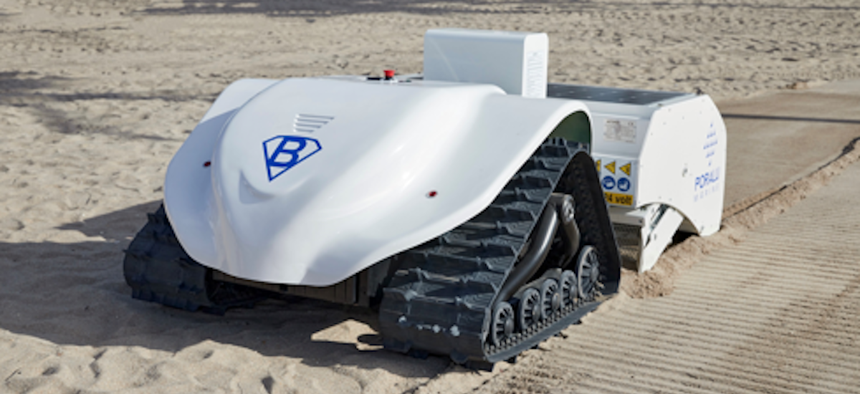In one city, litter meets its mechanical match

Photo courtesy of The Searial Cleaners
A pilot program in Detroit has enlisted a trash removal robot to reduce plastic pollution on the beach from entering local waterways.
Every April 22, Earth Day events raise awareness for environmental conservation and protection. Many impassioned nature lovers will be planting trees, encouraging their neighbors to recycle and helping clear up overgrown vegetation and remove litter in nearby parks.
In Detroit, a trash removal robot is joining the cause. On Monday, the remote-controlled BeBot robot will be demoed at Belle Isle Beach, a 985-acre island park located in the Detroit River near downtown. BeBot will sift through the sand and suck out trash like cigarette butts, bottles, food wrappers and other small pieces of plastic to help prevent trash making its way from the Detroit River, which flows between the U.S. and Canada, into Lake Erie.
The robot is roughly the size of a riding lawn mower and weighs more than 1,300 pounds. It uses a metal grate to sift through the sand and pick up trash as it rolls along beachfronts at about 2 miles per hour.
To ensure future climate and environmental resilience, it’s crucial to prevent plastic litter from entering nearby bodies of water, according to Genevieve Rattray, director of sustainability and advocacy at the Belle Isle Conservancy, a nonprofit dedicated to protecting and restoring the natural environment.
“Microplastics, a direct result of plastic production and use, are harming the organisms essential for the ocean to absorb CO2 emissions, which allows it to effectively moderate the Earth’s climate,” Rattray told Route Fifty in an email.
The Belle Isle Conservancy will operate the device during public cleanup events and analyze the collected trash to better understand the sources of litter and how it travels through the environment, city officials said in an April 9 announcement. The robot’s official launch is June 8 in recognition of the conservancy’s World Ocean Day celebration.
Prior to the robot’s Earth Day debut, the Belle Isle Conservancy conducted “rigorous testing” to assess the robot’s trash removal efficiency, city officials said.
When asked about testing results, Rattray said, “The BeBot is an effective tool to identify and remove plastic from our local beaches, preventing it from polluting the shared, international Detroit River, the Great Lakes of North America and our world’s ocean.”
The BeBot has been deployed in Michigan, Ohio and Wisconsin to remove and analyze how plastic litter moves along Great Lakes beaches. On Belle Isle, the robot will help officials develop ways to address pollution in the greater Great Lakes basin.
In the city of Muskegon in west Michigan, for instance, BeBot picked up more than 6,000 pieces of materials at Pere Marquette Park in 2022. Sixty-five percent of the collected materials were plastic bits, most of which were around 3 centimeters in size.
BeBot can cover 32,000 square feet per hour, and the electric robot’s battery is solar-supplemented, Rattray said. It can operate for about three hours on a single charge, and the solar panel could add an additional 30 minutes of power.
The BeBot program is a collaboration between the city and other partners including the Belle Isle Conservancy, the state Department of Natural Resources, the Council of the Great Lakes Region Foundation, the Midwest retailer Meijer and The Clorox Company, which granted $150,000 to the CGLR Foundation to support the pilot program. The robot cost $72,500, Axios reported.
Detroit officials said they would like to fund the addition of another BeBot robot and PixieDrone, a remotely operated floating waste collector to collect trash in the water at Belle Isle Beach. Their efforts support the Great Lakes Plastic Cleanup initiative, which leverages innovative technology to remove plastics at marinas from the Great Lakes. It is supported by federal, state and local governments as well as international organizations and research institutions.
Someday, robots might be a feasible solution for state and local governments looking to reduce pollution and litter, Konnor Petz, senior mobility strategist at the city’s Office of Mobility Innovation, said in an email to Route Fifty. But for now, the city will watch how the BeBot program rolls out to determine its return on investment.






